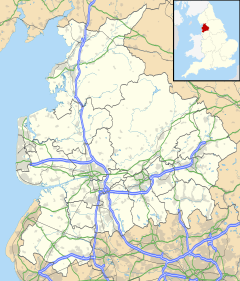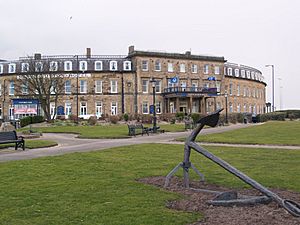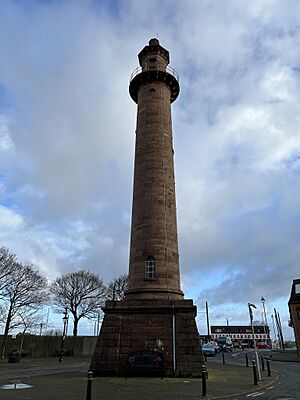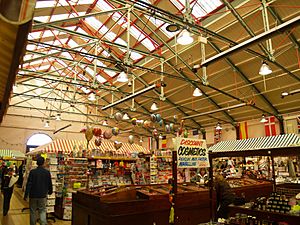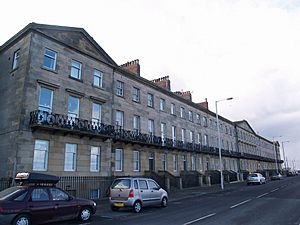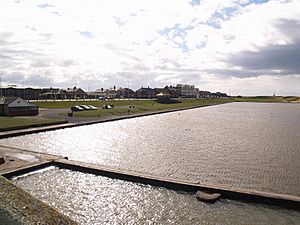Fleetwood facts for kids
Quick facts for kids Fleetwood |
|
|---|---|
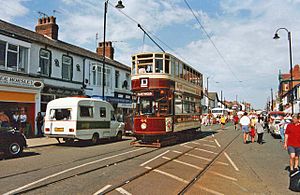 Lord Street in 1997 during the Fleetwood Transport Festival |
|
| Population | 25,939 (2011 Census) |
| OS grid reference | SD333479 |
| Civil parish |
|
| District |
|
| Shire county | |
| Region | |
| Country | England |
| Sovereign state | United Kingdom |
| Post town | FLEETWOOD |
| Postcode district | FY7 |
| Dialling code | 01253 |
| Police | Lancashire |
| Fire | Lancashire |
| Ambulance | North West |
| EU Parliament | North West England |
| UK Parliament |
|
Fleetwood is a town on the coast in Lancashire, England. It's located at the northwest tip of an area called the Fylde. In 2011, about 25,939 people lived there.
Fleetwood started to look like it does today in the 1830s. A rich landowner and politician named Peter Hesketh-Fleetwood had a big idea. He wanted to turn Fleetwood into a busy seaport and a place where trains could connect with ships. He hired a famous architect, Decimus Burton, to design many important buildings, including two lighthouses.
Even though his big transport plans didn't fully happen, the town grew a lot in the first half of the 1900s. This was thanks to the growing fishing industry and passenger ferries that went to the Isle of Man. Fleetwood became a major port for deep-sea fishing.
However, the fishing industry started to shrink in the 1960s, partly because of conflicts over fishing rights with Iceland (called the Cod Wars). Even so, processing fish is still a big part of Fleetwood's economy. Today, the most important employer in town is Lofthouse of Fleetwood. They make the famous Fisherman's Friend lozenges, which are sold all over the world!
Contents
History of Fleetwood
Early Days and Roman Times
Long ago, around the 2nd century AD, a tribe called the Setantii lived in this area. Ancient maps from that time show a Roman port called PORTVS SETANTIORVM near what is now Morecambe Bay. There's also evidence of a Roman road that might have led to Fleetwood. This suggests that Fleetwood could have been the site of this Roman port, but no direct proof has been found yet.
Later, in the 9th and 10th centuries, there's evidence that Danish invaders lived on the eastern side of the River Wyre. By 1086, the land where Fleetwood now stands was part of a larger area called Amounderness.
A large house, or manor house, at Rossall (in the southwest of town) belonged to the Allen family by the time of King Henry VIII. A famous Catholic leader, Cardinal William Allen, was born there in 1532. The land eventually went to the Fleetwood family and stayed with them for 300 years.
Building a New Town in the 1800s
By the 1830s, the estate belonged to Peter Hesketh. He believed that Fleetwood's sheltered harbour and views of Morecambe Bay made it perfect for a busy seaport and a popular holiday spot. He dreamed of Fleetwood being a place where people could switch from trains coming from London to steamers going to Scotland.
In 1831, Peter Hesketh changed his name to Peter Hesketh-Fleetwood and decided to name the new town Fleetwood. He hired the famous architect Decimus Burton to design the town. This made Fleetwood the first planned town of the Victorian era. Building started in 1836.
Burton's plan was clever. He used the biggest sand-dune on the coast, called the Mount, as the center of a half-wheel shaped street layout. The main streets spread out like spokes from the Mount. The oldest building still standing, the custom house (now Fleetwood Museum), was built in 1836. The most impressive building was the North Euston Hotel, built in 1841. It was designed for people traveling by train from Euston in London, before they boarded steamers to Scotland. Even Queen Victoria stayed there in 1847! However, by the 1850s, a new railway line made Fleetwood less important for this journey.
Decimus Burton also designed two lighthouses for the town: the Upper Lighthouse, known as the Pharos, and the Beach Lighthouse. Both opened in 1840. A third lighthouse, Wyre Light, was built offshore in 1839–40. It was the first screw pile lighthouse in Great Britain. Fleetwood is the only town in the UK with three lighthouses, and the two in town still work today.
Fleetwood Market, a large permanent market, was started in 1840 and is still popular.
By the late 1830s, Peter Hesketh-Fleetwood faced money problems. He had to sell much of his land. He leased Rossall Hall to the Church of England, which opened Rossall School, a boarding school.
From the 1860s, Fleetwood's port became busier. Steamers offered trips to the Isle of Man, Ardrossan, and Belfast. The fishing industry also grew, with boats traveling further into the North Atlantic Ocean. At first, all fishing boats were sail-powered. The first steam-powered trawler, the Lark, was launched in 1891. This helped Fleetwood become one of England's top three fishing ports by the early 1900s.
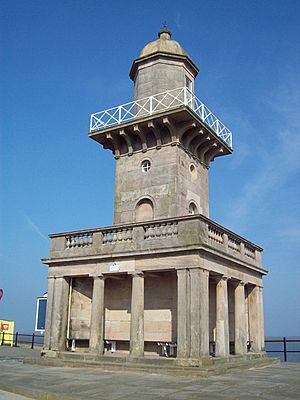
An electric tramway link to Blackpool was built in the 1890s and is still used today. Fleetwood is special because its trams run right down the main street, sharing the road with cars. The docks were expanded in 1908 with the Fish Dock, which is still used by smaller fishing boats. The Fleetwood Pier was built in 1910, the last new seaside pier built in the UK for many years.
The 1900s and Today
By the 1920s, the fishing industry was at its peak, employing over 9,000 people. The seafront was developed with attractions like the Marine Hall (1935), a golf course (1931), and the Model Yacht Pond (1932) to attract tourists. A large chemical plant, ICI Hillhouse, also became a major employer.
In October 1927, a huge flood covered 90% of the town. Only the higher areas around the Mount were spared. More houses were built in the 1920s and 1930s.
However, Fleetwood's economy started to decline in the 1960s. The last regular ferry to the Isle of Man sailed in 1961. The main railway station closed in 1966, and the railway line was completely shut down in 1970.
The rise of package holidays abroad meant fewer visitors to British seaside towns. The biggest blow was the collapse of the fishing industry in the late 1960s and early 1970s, mainly due to the Cod Wars. Since Fleetwood's trawlers mainly fished for cod in the North Atlantic Ocean, this loss hit the town very hard. The last deep-sea trawler left in 1982. Today, only smaller inshore fishing boats use the port, but fish processing is still a big industry.
In 1973, the old railway station area became a container port. This helped bring some life back to the Dock Street area. However, the container service stopped in 2010.
Since the 1970s, there have been efforts to improve Fleetwood's economy. In 1995, the old Wyre Dock was turned into a marina. The nearby land became Affinity Lancashire (formerly Freeport), an outlet shopping village. In 2007, a "Masterplan" was created to make the waterfront and town center even better.
Local Government
Since 1974, Fleetwood has been part of the Wyre Borough, which also includes nearby towns like Thornton Cleveleys. The main office for the borough council is in Poulton-le-Fylde.
In 2009, a local parish council called Fleetwood Town Council was created. It has 13 councillors and helps manage local services and projects for the town.
For national elections, Fleetwood is part of the Lancaster and Fleetwood constituency.
Geography and Climate
Town Layout
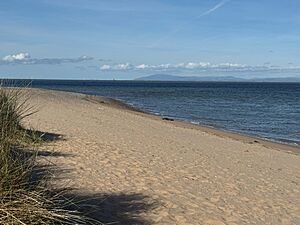
Fleetwood is located at the very top of the the Fylde coast. It's about 8 miles (13 km) north of Blackpool. The town is on a peninsula, meaning it's almost surrounded by water: the Irish Sea to the west, Morecambe Bay to the north, and the River Wyre to the east. This means there are only a few roads leading into and out of town.
The land in Fleetwood is very flat. The highest point is the Mount, a large sand dune in the northern part of town. Parts of Fleetwood are very close to sea level, so a big sea wall protects the town from high tides. Despite this, Fleetwood has experienced floods in the past, like in 1927 and 1977.
Weather in Fleetwood
Like other coastal areas in the UK, Fleetwood has a maritime climate. This means the weather is influenced by the sea. Winds usually come from the northwest, bringing a bit more rain than the rest of the country. However, because there are no high hills nearby, the rain isn't too extreme. It rarely gets very cold, so frost and snow are not common. Temperatures are generally similar to the national average.
| Climate data for Fleetwood, England, United Kingdom | |||||||||||||
|---|---|---|---|---|---|---|---|---|---|---|---|---|---|
| Month | Jan | Feb | Mar | Apr | May | Jun | Jul | Aug | Sep | Oct | Nov | Dec | Year |
| Mean daily maximum °C (°F) | 6.8 (44.2) |
7.1 (44.8) |
9.1 (48.4) |
11.6 (52.9) |
15.2 (59.4) |
17.3 (63.1) |
19.4 (66.9) |
19.4 (66.9) |
17 (63) |
13.7 (56.7) |
9.8 (49.6) |
7.6 (45.7) |
12.9 (55.2) |
| Mean daily minimum °C (°F) | 1.7 (35.1) |
1.6 (34.9) |
3.1 (37.6) |
4.2 (39.6) |
6.9 (44.4) |
10 (50) |
12.4 (54.3) |
12.3 (54.1) |
10.2 (50.4) |
7.3 (45.1) |
4.3 (39.7) |
2.5 (36.5) |
6.4 (43.5) |
| Average precipitation mm (inches) | 81.1 (3.19) |
58.7 (2.31) |
68.3 (2.69) |
48.9 (1.93) |
49 (1.9) |
59.8 (2.35) |
59.5 (2.34) |
73.4 (2.89) |
82.5 (3.25) |
97.9 (3.85) |
94 (3.7) |
98.3 (3.87) |
871.3 (34.30) |
| Source: UK Met. Office | |||||||||||||
Economy and Jobs
Fleetwood's economy still relies on its traditional industries: fishing, tourism, port activities, and light industry. However, since the 1970s, the town has faced economic challenges.
The decline of the fishing industry meant a loss of many jobs. The closure of the ICI Hillhouse chemical plant also caused many job losses. Today, the biggest employer in Fleetwood is Lofthouse's, which makes Fisherman's Friend lozenges.
There are plans to help Fleetwood's economy grow, focusing on improving the waterfront and town center. These plans include better transport links, new entertainment areas, and more shops.
Culture and Fun Things to Do
Parks and Piers
The most famous spot in Fleetwood is the Mount. It's a large park facing the sea, built on a big sand dune. At the top, there's a pavilion with a clock that was added in 1919. It's a great place to enjoy the views.
Fleetwood Memorial Park is another lovely green space. It was renamed in 1917 to remember those who died in the First World War. The park has bowling greens, a children's play area, a duck pond, and tennis courts.
Fleetwood Pier, also known as 'Victoria Pier', was a landmark from 1910 until it was destroyed by fire in September 2008. It was the last new pleasure pier built in the UK for many years. It was once an amusement complex, bar, and dance hall. Sadly, after the fire, the pier was completely taken down and has not been rebuilt.
Shopping and Museums
Fleetwood has two main shopping areas. Affinity Lancashire (formerly Freeport Fleetwood) opened in 1995. It's an outlet shopping village with many shops, located by the marina.
Fleetwood Market on Victoria Street is one of the biggest covered markets in the North West of England, with over 250 stalls. It first opened in 1840, and the current stone building dates from 1892.
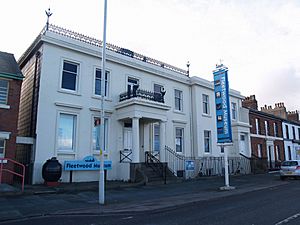
Fleetwood Museum is on Queen's Terrace. This building, designed by Decimus Burton, was finished in 1836 and is the oldest building in Fleetwood. It used to be the Customs House and later the Town Hall. Since 1992, it has been the town's museum, telling the story of Fleetwood's fishing industry. The museum also used to have the Jacinta, a "heritage trawler" that people could visit, but sadly, it was scrapped in 2019.
Churches and Buildings
Fleetwood has several interesting churches. St Peter's, designed by Decimus Burton in 1841, is the town's main church. St Mary's is the main Roman Catholic church, built in 1867. A more modern church is the copper-roofed St Nicholas, completed in 1962.
Many other buildings designed by Decimus Burton are still in Fleetwood. The Pharos and Lower Lighthouses, opened in 1840, are still working. The Pharos is unique because it's a functioning lighthouse built right in the middle of a street! The North Euston Hotel (1841) is still the largest hotel. Queen's Terrace (1844) is known for its beautiful classical architecture.
Local Media
The Fleetwood Weekly News covers news for the town. The Blackpool Gazette provides daily news for the area.
Festivals and Music
Fleetwood hosts several fun festivals each year. The Fylde Folk Festival celebrates traditional and modern folk music, song, and dance. Fleetwoodstock is another music festival, named after the famous Woodstock Festival. The Yuto Fest is a charity music festival featuring local bands.
The Fleetwood Transport Festival, also known as Tram Sunday, happens every July. It's a festival of old vehicles, especially historical tram-cars, which parade along Lord Street. There's also a Beer & Cider Festival in February.
Many musicians have connections to Fleetwood. The young John Lennon (from the Beatles) spent summer holidays here and even played at the Marine Hall with his band in 1962. Operatic tenor Alfie Boe grew up in Fleetwood and had his first public performance at the Marine Hall when he was 14.
Sports in Fleetwood
Fleetwood has a strong football history. The current club, Fleetwood Town F.C., is nicknamed the Fishermen. They have played in the Football League since 2012, which is a big achievement for a town of Fleetwood's size! Their home games are played at Highbury Stadium.
Speedway racing also took place at Highbury Stadium from 1948 to 1952.
Fleetwood Rugby Union Football Club and Fleetwood Cricket Club are also active in the town. The Model Yacht Pond, built in 1932, is one of Europe's largest and hosts many national and international championships.
Fleetwood is also a popular spot for kitesurfing and other power kite sports, thanks to its suitable beaches.
Getting Around Fleetwood
Fleetwood is at the northern end of the Blackpool tramway. Trams run right through the town on Lord Street and North Albert Street, sharing the road with cars. Buses also connect Fleetwood to Blackpool, Preston, and other local places.
You can take a short passenger ferry ride across the River Wyre to Knott End-on-Sea.
For many years, there were only two roads into and out of Fleetwood. In the late 1970s, Amounderness Way was built to improve road access, especially for port traffic.
Fleetwood used to be the end of the railway line to London, which is why the North Euston Hotel is named that way. The railway also carried fish from the docks to markets. Passenger train service to Fleetwood stopped in 1970. The nearest train stations are now in Poulton-le-Fylde and Blackpool North. However, there are plans to reopen the railway line to Fleetwood in the future!
Schools and Learning
Rossall School is an independent school for students aged 5 to 18, located on the site of Rossall Hall.
Fleetwood has two main public secondary schools: Fleetwood High School and Cardinal Allen Catholic High School.
For higher education, the Nautical Campus of Blackpool and The Fylde College is in Fleetwood.
There are seven public primary schools in Fleetwood, serving different parts of the town. There are also two Roman Catholic primary schools.
The town also has a large public library, where you can borrow books and other materials, and find information about local history.
Famous People from Fleetwood
- William Allen (1532–1594) – A Catholic cardinal.
- Alfie Boe (b. 1973) – A famous opera singer (tenor).
- Decimus Burton (1800–1881) – The architect who designed much of Fleetwood.
- Stuart Chatwood (b. 1969) – Bass player for the band The Tea Party.
- Jane Couch (b. 1968) – A former boxing champion.
- Peter Hesketh-Fleetwood (1801–1866) – The founder of Fleetwood.
- Syd Little (b. 1942) – Half of the comedy duo Little and Large.
- Wes Newton (b. 1977) – A professional darts player.
- Charles Kay Ogden (1889–1957) – A linguist and philosopher.
- Jean Rigby (b. 1961) – An opera singer (mezzo-soprano).
- John Robb (b. 1961) – A musician and writer.
Images for kids
See also
 In Spanish: Fleetwood (Lancashire) para niños
In Spanish: Fleetwood (Lancashire) para niños


